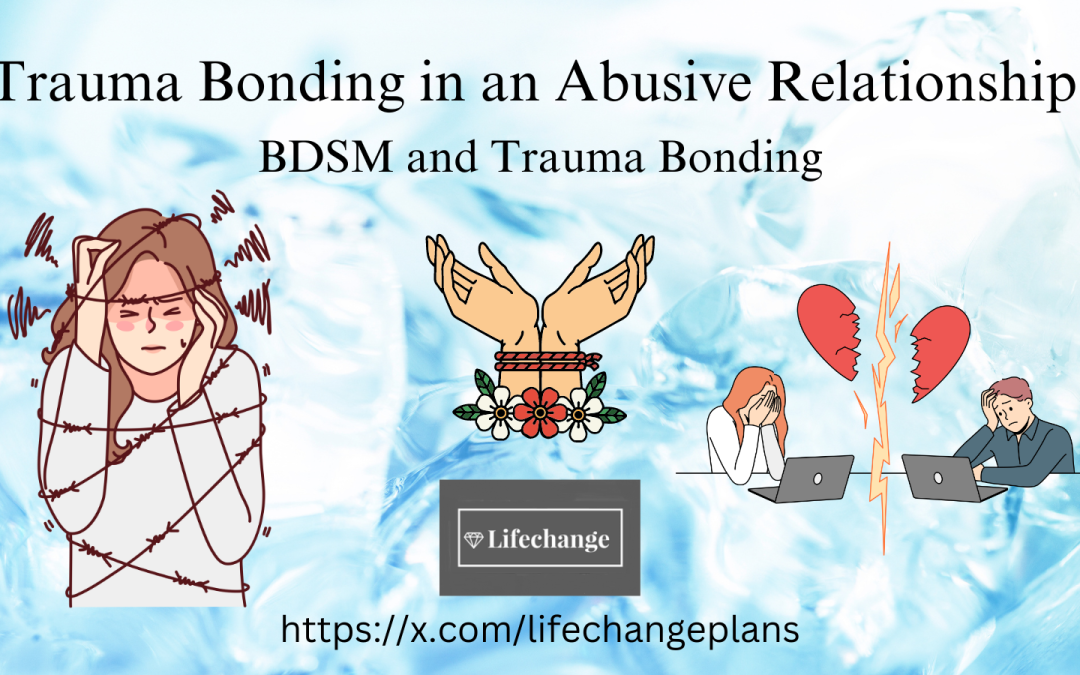Understanding Toxic Trust
Trauma bonding is a psychological phenomenon where an abused person forms a deep, emotional attachment to their abuser. This bond is forged through cycles of abuse and intermittent kindness. This leaves the victim confused, emotionally dependent, and trapped in the relationship. In abusive relationships, particularly those involving narcissistic behaviour, trauma bonds are maintained through emotional, psychological, and sometimes physical manipulation. This makes it difficult for victims to leave even when the relationship is damaging or dangerous.

The Narcissistic Cycle of Abuse
Abusive relationships often follow a predictable cycle, especially when narcissism is involved. Narcissists manipulate their victims through a cycle that includes idealisation, devaluation, and discard.
Idealisation: At the beginning of the relationship, the narcissist appears charming, attentive, and affectionate. They build the victim up, making them feel special and loved. They often create grand future plans, which is a form of future faking. This phase serves to hook the victim emotionally, making them believe they’ve found their perfect partner. Plans often include moving away from family and friends, a new home, or a new career. This point can lead to the next stage of the cycle.
Devaluation: Over time, the narcissist begins to criticise, belittle, and emotionally abuse their victim. This phase is marked by gaslighting, blame-shifting, and emotional withdrawal, leaving the victim confused and desperate to return to the love they experienced in the idealisation phase.
Discard: In the final phase, the narcissist may abruptly end the relationship, leaving the victim devastated. Sometimes, they move on to another partner, leaving the previous victim emotionally and mentally broken.
This cycle creates a trauma bond, which is intensified by the intermittent reinforcement of kindness between episodes of abuse. The emotional rollercoaster of highs and lows mirrors addiction, making it incredibly hard for victims to break free.

Physical Abuse and Trauma Bonding
For women who experience physical abuse, trauma bonding can also involve the abuser alternating between violent outbursts and periods of remorse or tenderness and gift giving. The victim may rationalise the abuse, believing that the abuser is sorry or that they “didn’t mean it.” The abuser often makes promises to change, creating hope that the relationship will improve, only to return to their abusive behaviour.
This dynamic causes emotional confusion as the victim struggles to reconcile the caring behaviour with the violence they endure. Over time, they may become desensitised to the abuse and find it harder to leave as fear and dependency set in. In the book “In Control Dangerous Relationships And How They End In Murder.” Author Jane Monkton Smith describes a scene from when she was a Police Officer attending a Domestic Abuse incident. It is obvious there has been a physical assault on the woman, yet she refuses to explain what happened and does not want to attend the hospital to get medical attention. This was a typical scenario when attending a “domestic.” Jane asked her sergeant, “Why won’t she get in the Ambulance?” Her sergeant replied, “Get used to it.”

Consensual BDSM and Trauma Bonding
In consensual BDSM relationships, there is often a high level of trust between the dominant and submissive partners. The submissive partner willingly cedes control to the dominant, which can create a powerful emotional bond. When boundaries are crossed, or the relationship becomes unhealthy, or the use of alcohol or drugs comes into play, there are issues of safety concerns, manipulation, and coercion. A person cannot give consent if they are under the influence of alcohol or drugs. This is not real BDSM. Real BDSM is not abusive. This dynamic can evolve into a trauma bond.
The submissive partner may feel obligated to stay in the relationship due to the deep trust they’ve placed in the dominant. If the dominant begins to abuse their power—emotionally, psychologically, or even physically—the submissive may struggle to differentiate between consensual dynamics and outright abuse. Over time, the trust can become toxic, and the submissive becomes trauma-bonded to their abuser, much like Stockholm syndrome, where the victim develops empathy for their captor.
In these situations, the submissive partner may find it difficult to leave. Their identity, self-worth, and emotional stability are tied to the dominant partner. Just like in other abusive relationships, they may feel dependent on the abuser. The victims believe that they cannot survive or be “whole” without them.
Trauma Bonds and Addiction
The experience of trauma bonding can be likened to addiction. The cycle of abuse triggers the release of certain hormones in the brain, such as adrenaline during moments of fear and cortisol during stress. But the most powerful chemical at play is dopamine, which is released during the brief periods of affection or kindness from the abuser. These hormonal highs and lows keep the victim emotionally tethered to the abuser, much like a drug addict seeks the next fix. The devaluation cycle can move between super kind, super nice and gift-giving to blame, criticism, name-calling, anger, rage intimidation and threats. I call this the Dr Jekyll, Mr Hyde, or the Man and the Monster.
The victim may crave the emotional “highs” that come with the abuser’s moments of kindness, and these small gestures can keep them trapped in the relationship, hoping for the next positive interaction. The abuser has often conditioned or groomed the victim to accept the cycle, making it incredibly difficult to break free.
Entrapment and Toxic Loyalty
Victims of trauma bonds often remain in abusive relationships due to a sense of toxic loyalty and financial dependency. With the fear of homelessness and financial insecurity, the victim becomes entrapped. The abuser has groomed them to believe that they are unworthy or incapable of surviving independently, which fuels the cycle of control and dependency. Even when the abuser leaves the relationship and starts a new relationship, they will often return to pick up where they left off. Returning to their discarded victim months or years later. This is known to be a part of the narcissistic abuse cycle known as hoovering. Hoovering is a manipulative tactic used to lure or suck a person back into a relationship. The presence of a trauma bond in a person who is unaware will assist the abuser in reasserting power and control.
Five Ways To Break the Trauma Bond
Breaking free from a trauma bond is challenging, but it is possible. Here are five steps to begin the healing process:
Acceptance of the Truth: The first step is accepting the reality of the situation. Educating yourself on the cycle of abuse, narcissism, and trauma bonding can help you understand that the relationship is unhealthy. Recognizing that the abuser will not change is crucial to breaking free
Mindfulness and Trusting Your Intuition: Stay grounded in the present moment. Mindfulness practices can help you tune into your inner wisdom, allowing you to recognize and trust your intuition. Learning to distinguish between emotional manipulation and reality will give you the clarity needed to take action.
Set Small Goals for Positive Change: Moving toward a healthier life requires small, actionable steps. Whether it’s seeking therapy, setting boundaries, or saving money to secure your independence, each small goal brings you closer to freedom.
Pattern Interrupt and Breath Work: Learning breathing techniques or trying new activities can help you disrupt emotional trauma or rumination over past events. This helps rewire the brain and provides emotional relief, allowing for healthier coping mechanisms. For example, you can use aroma therapy, like lavender for calm and citrus for uplift, or attend low-impact yoga sessions.
Self-Care and Writing as a Healing Tool: Taking time for self-care is vital. Meditation, relaxation exercises, and affirmations help build strength and resilience. Writing can also be a powerful way to heal. Expressing your emotions through creative writing or journaling, or even writing a letter to your ex, allows you to release pent-up feelings and gain perspective on your experiences. Documenting the bad memories helps to release the pain and begin the healing process.
Conclusion
Trauma bonding in an abusive relationship is a complex, deeply rooted emotional and psychological trap that can be hard to break. Whether it’s emotional manipulation, physical abuse, or toxic trust in consensual BDSM dynamics that have turned abusive, understanding the mechanisms of trauma bonding is the first step in breaking free. Through education, mindfulness, small steps toward independence, and self-care practices like writing, victims of trauma bonding can regain their strength, rebuild their lives, and find the freedom they deserve.
Breaking the trauma bond is a journey of healing and transformation—one that begins with recognising the truth and taking action to reclaim your life.
(This content contains affiliate links. We may earn a commission if you use these links to purchase something. Thanks.)


